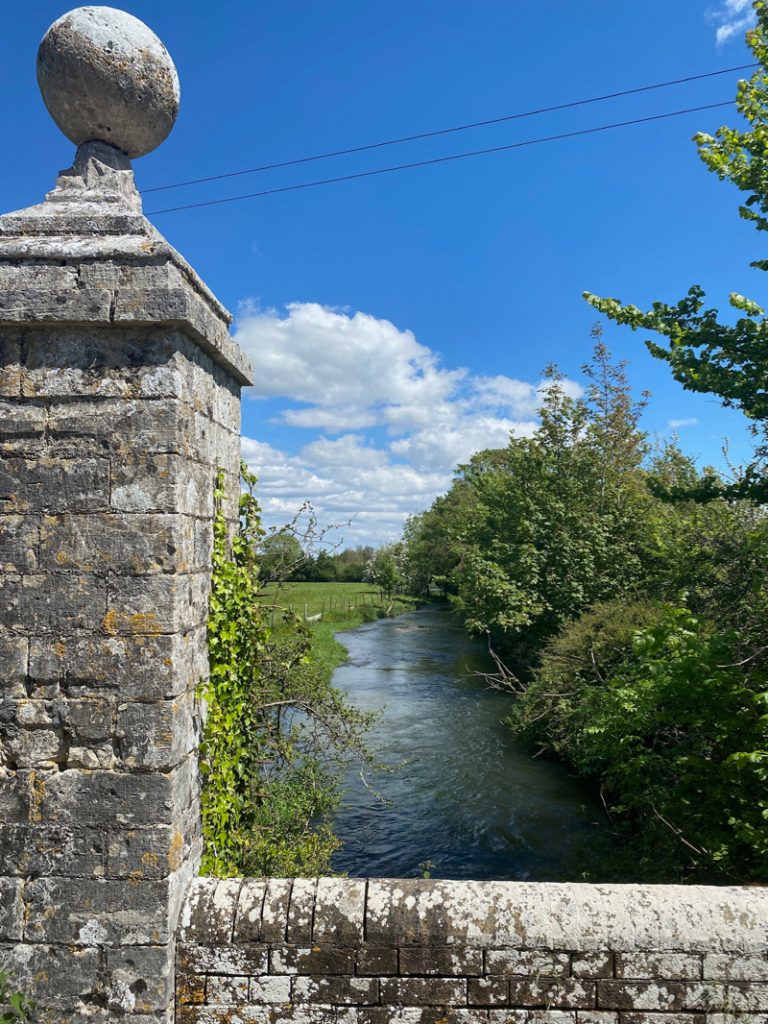
Wolveton ( or Wolfeton) House stands in its little plot of green verdant land bordered by water meadows to the north-west of Dorchester, where trees and docks grow tall and small creeping flowers with medieval names push up through the turf
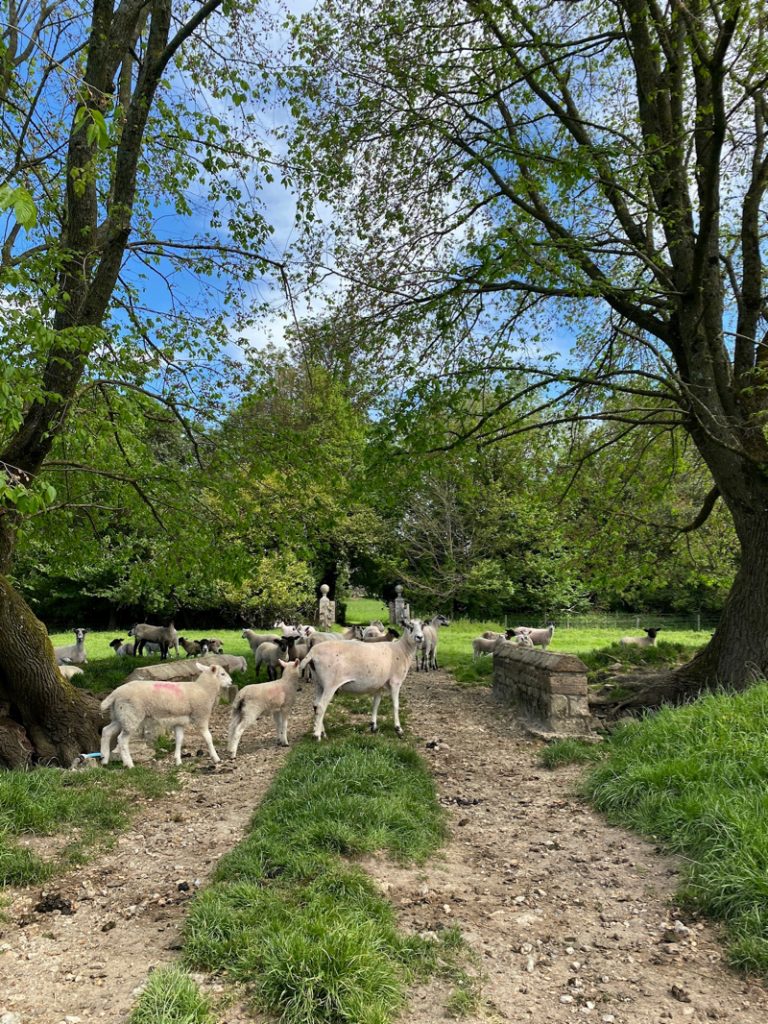
Lazy sheep dung the old rutted carriage drive and slow everything down

remains of a moat?
The gatehouse towers incorporate gun-loops covering the entrance and large dovecots in the upper sections. The Trenchard family inherited Wolfeton in 1480 and there was a substantial late medieval house here

Archduke Philip of Austria and Joanna of Castile slept at Wolfeton in 1506 after a storm blew them in en voyage to lay claim to the throne of the Netherlands.
Now the gatehouse’s upper guest-chambers can be rented for holidays via the architectural charity, the Landmark Trust. Wolfeton belongs to Captain Captain Nigel Trwhitt Lumley Luttrell Thimbleby and his wife Katherine, nee Weld, of Lulworth Castle.

The house that stands now is Elizabethan, with truly superlative decorated plaster ceilings, overmantels and carved woodwork . What had begun as a compact courtyard house was enlarged in a flamboyant style by Sir George Trenchard – probably to celebrate his knighthood received from Elizabeth I in 1588 – but in the 1820s large parts of his house were demolished. The manuscript under this antiquarian drawing says, ‘… the house where Ferdinand and Isabella, King and Queen of Spain, were received when shipwrecked on the coast of Dorset-shire in Henry 7th reign.’
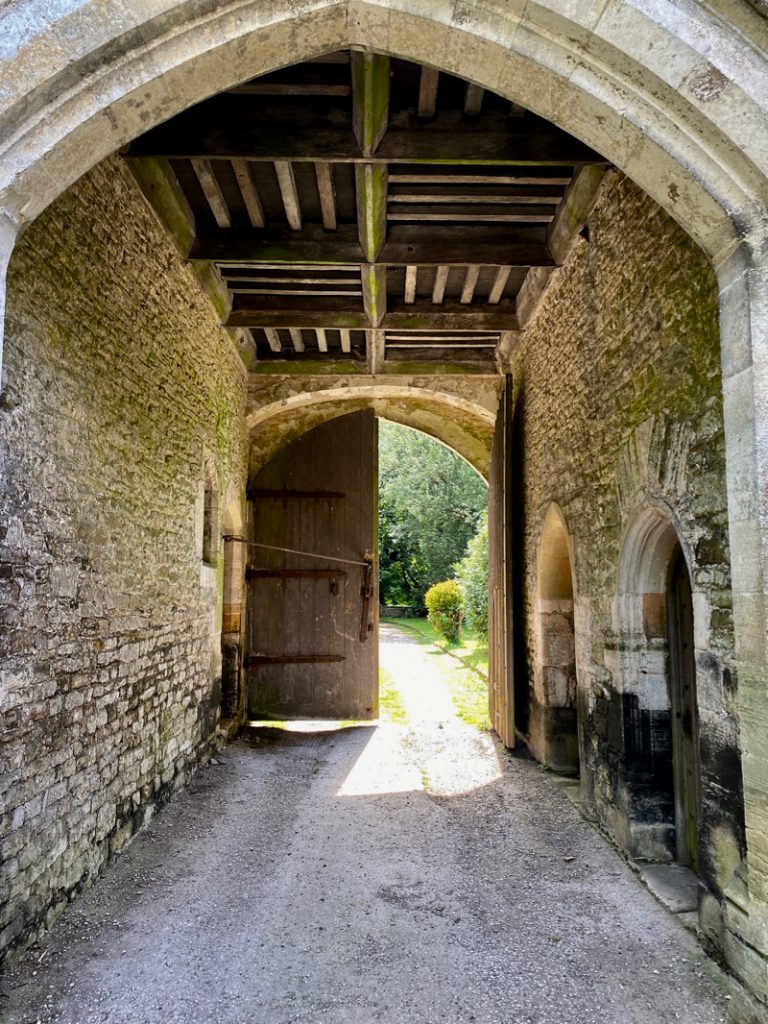
An arched doorway on the right leads up the ancient spiral stair to the gatehouse apartment available to rent through the Landmark Trust. The door on the left opens onto the chapel.
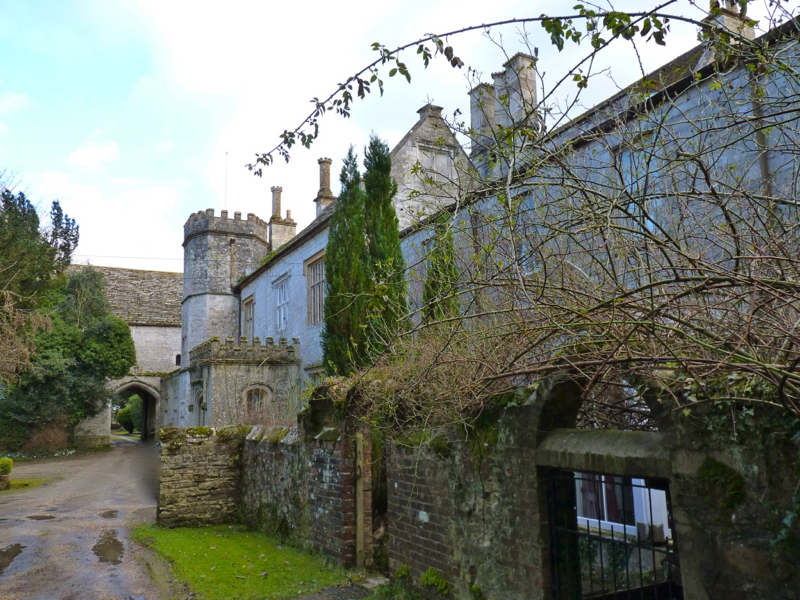
The courtyard looking back towards the gatehouse. I was last here in 2010 and had wanted to photograph and write about this extraordinary house properly ever since then.
But now this story has become a more urgent one: developers are planting the fields around the village of Charminster with new houses that will march all the way up to Wolfeton’s treeline a field or two away. The pictures that follow will show you the spirit of this place and make the argument to drive the developers a little further back.

The chapel, seventeenth century altar rail
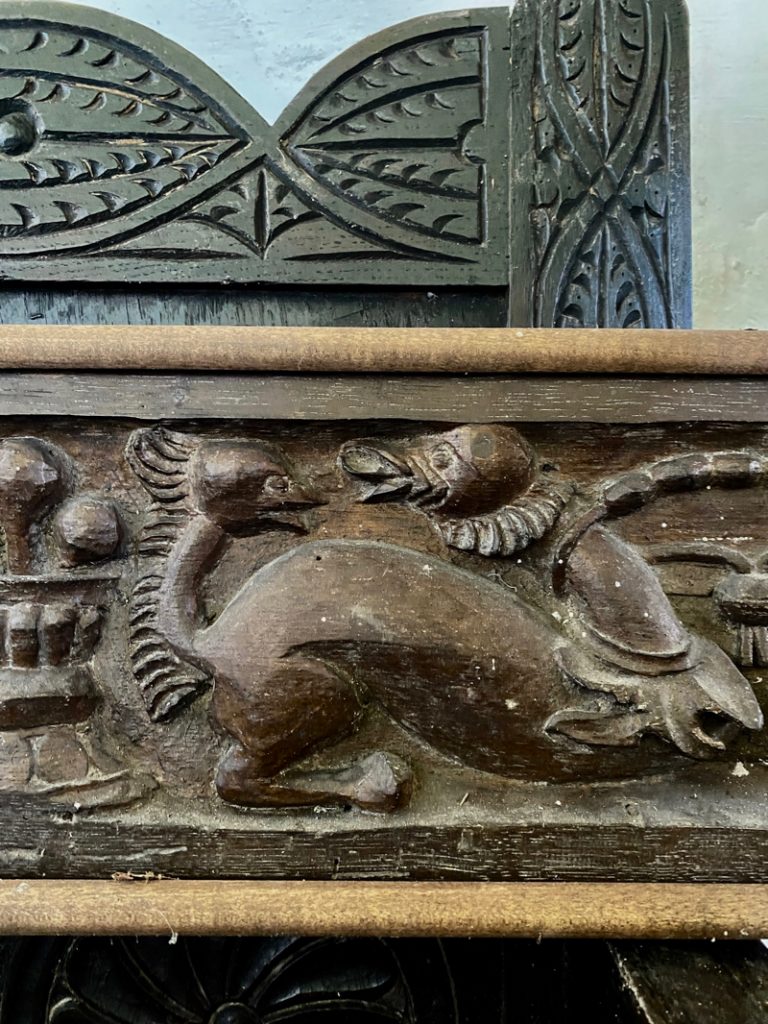
Ancient oak boiseries, a late C15th mythological sea monster
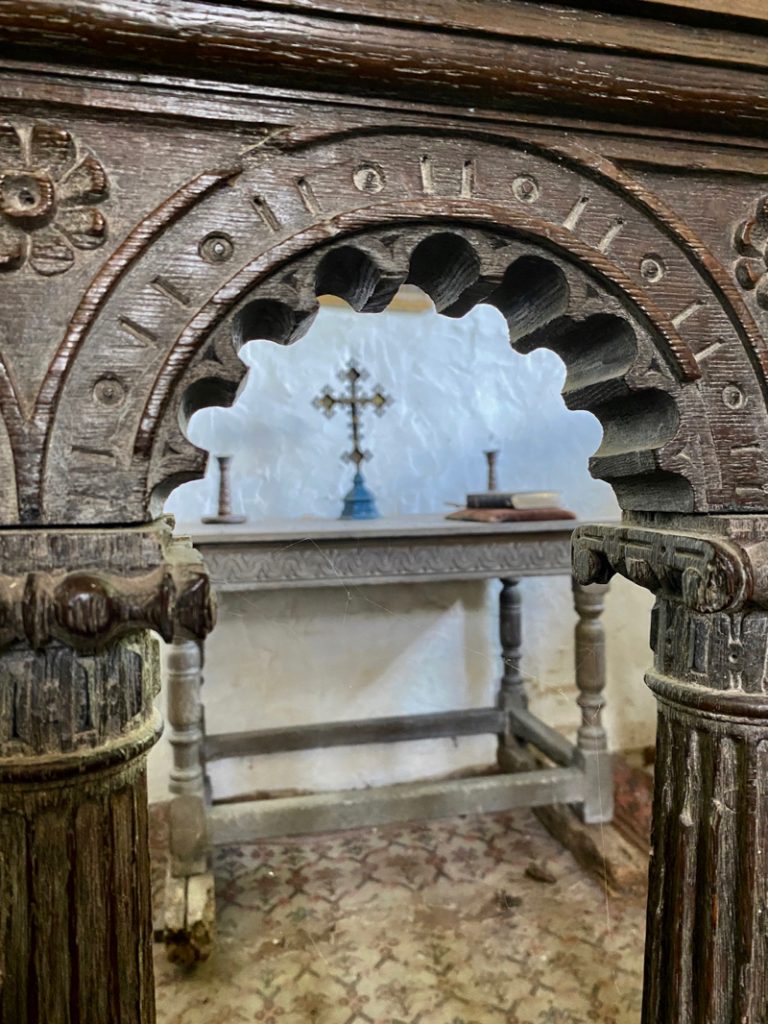
Poat-reformation altar table
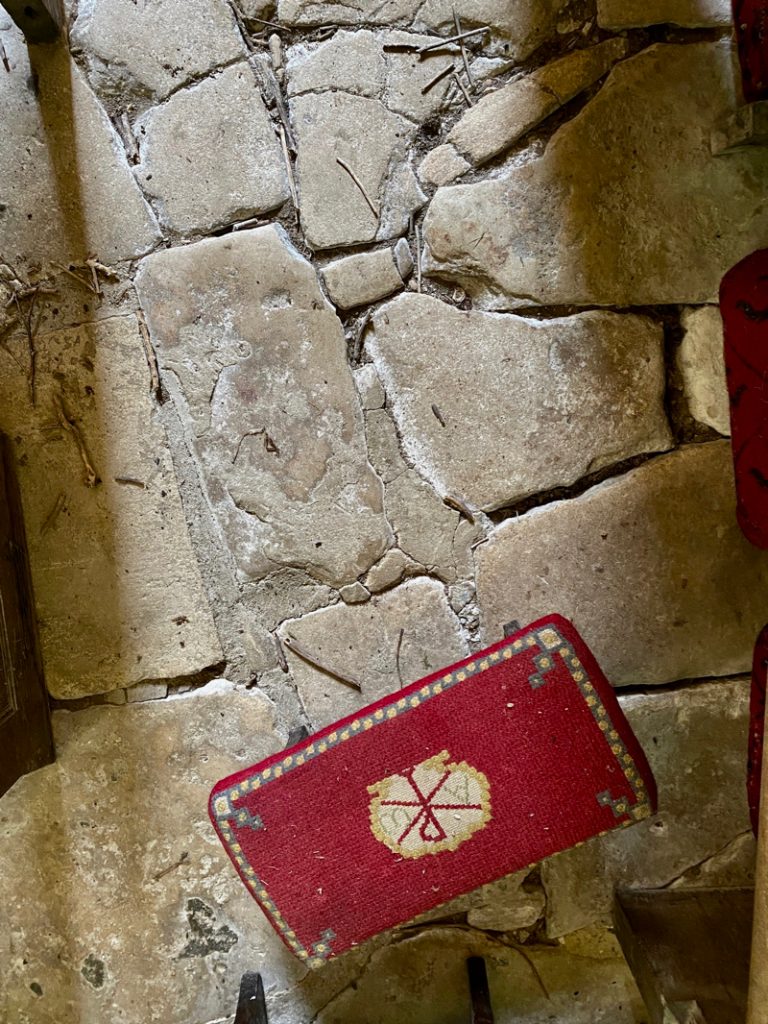
chapel pavement of Dorset-shire Blue Lias stone
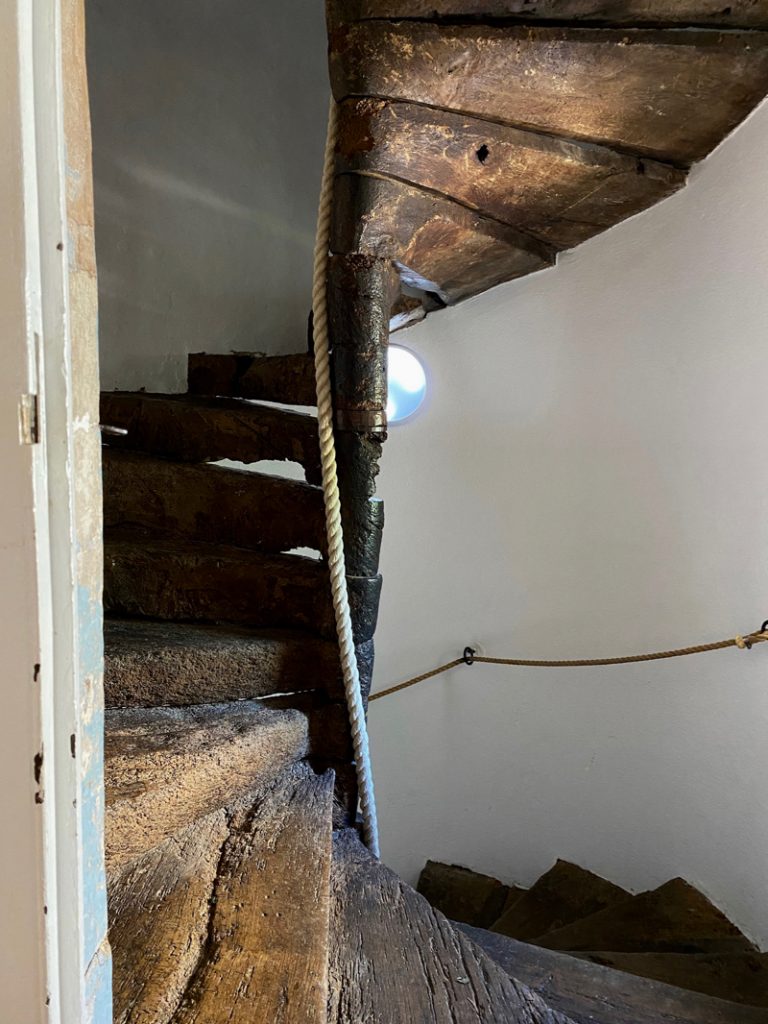
ancient turret stair in the gatehouse

detail of gatehouse chimneypiece in what was built as a fifteenth century guest chamber

gatehouse bedroom for the Landmark Trust, tapestry fragment with sleeping cupid. When Nigel Thimbleby married Katherine Weld in 1972, they lived at first in the gatehouse which was only starkly furnished, since most of Nigel’s family furniture had been sold.

gatehouse attic, ancient leather-bound chest and the bell

The entrance passage with extremely good stone vaulting and rustication around the doorway. Captain Thimbleby’s family bought Wolfeton in 1961.
‘We had a nice little property up in Oxfordshire which my father gambled away. It was actually a marvelous little estate, two settlements – both had a church and there are gated roads there. So, when my father flogged everything up in Oxfordshire my mother came down here. My family had a holiday house on the promenard in Weymouth and my mother was always extremely attached to that. She was ahead of her time in the 50s, buying houses and doing them up.’

‘I was in the army in Germany and she sent a telegram and said I think we ought to buy this house. The house had been converted by Priscilla Zamoiska, she’d married a Pole but she was a Stukeley from Devon and she’d divided it up into flats. We undivided the whole thing.’

‘We had four people helping,’ he says. ‘We still had a full-time butler, Herbert, and a full-time gardener, Harry. I had Mrs Kent and Mrs Norton. Mrs Kent’s sole job was scrubbing the stairs. ‘

‘We were building when the children were little – when Emma was born the house was full of dust – and when we moved here we started collecting furniture.’
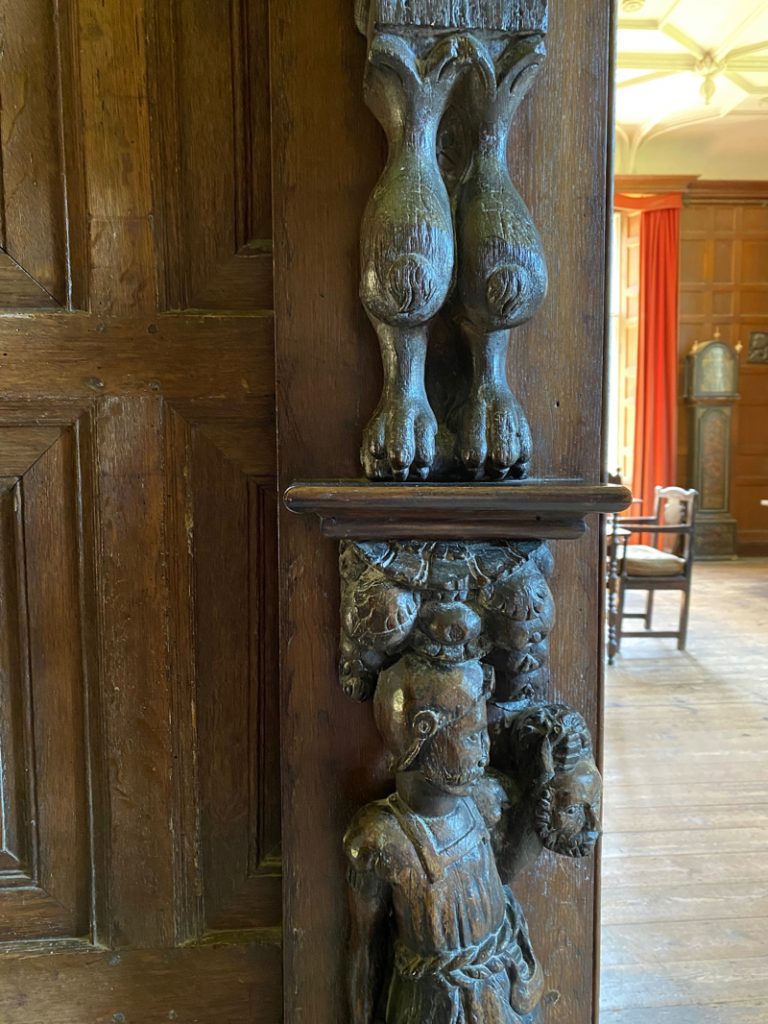
Looking into the Great Hall. The late sixteenth century doorway is carved with a figure of a Roman soldier, or possibly David holding the head of Goliath.

The Great Hall, redecorated and re-paneled in the late nineteenth century.
‘When we first got married we took the flats back bit by bit.
And the first thing we got was this end ground floor and the top flat, there were still people living in the middle – the other half of the great chamber, – an elderly couple,’ says Nigel. ‘We bought a box of chocolates because we’d been bribing the people in the middle flat to leave – I think they must have agreed… On no! It was for the dining room chairs, that was it, they were using them’

‘We used to have a village carol party in here every year with candles in the chandelier. We tried to get a long table for this room ,and then we had the idea of getting all these gate-leg tables that could join up, so we could take them all out and use it for parties. But it’s certainly not warm in winter. We retreat to the other end of the house,’

‘This room was a flat in itself, there was a bathroom in that corner.
You can see the replacement paneling in the corner – it’s two different colours. I had the most wonderful man called John, a brilliant craftsman he did that.’

Glass bowl engraved with a view of nearby Lulworth Castle and presented to Col. Sir Joseph Weld, Lord Lieutenant of Dorset, father of Katherine Thimbleby

Carving of Woodwose fighting a Centaur, c.1500.
After National Service Nigel stayed on in the army, serving in Germany, Aden and Cyprus. ‘Those were the happiest days to be a soldier, because we didn’t have many enemies and those we did have didn’t have anything to shoot at us with.’
His regiment was 11th Hussars. ‘Little, light cavalry regiments don’t really have a base. Our only connection with the mainland as it were, was that light cavalry regiments used to help territorial regiments. Our territorial regiment was the Gloucester Hussars, so we used to have one officer with them in Cirencester. Which was very convenient! So whoever it was did a couple of years with the Gloucester Hussars, hunting foxes. Even 30 years ago one led a very decent life as a junior officer in the cavalry. It still potters on a bit but the world has changed. When I was in the army you couldn’t get into the 11th Hussars unless your father had been, but that’s all changed now . It was like being put up for a club then.’

Detail of an embroidered hanging, and the story of how Nigel got his job as the local representative for Christies’ Fine Art auctioneers:
Nigel had an old friend, Martin Drury, they used to share a flat years ago, ‘When you come to think of it, he is entirely responsible for my whole career and life! I was in a hospital in London where I used to go for a rest quite a lot, and they told me I could go out to lunch one day.’

‘So I told old Martin and he said, ‘I’m taking somebody else out to lunch, you can join us. It was Paul Whitfield of Christies. He was looking for someone to be their regional representative down here, Martin said, Oh Nigel would be fine! Jo Floyd was the boss man, a smashing chap! He rang up and said, I understand you’d like a job, I suppose we’d better meet. Tell you what, come up to lunch next week. I thought, I’ve only got two days, I can’t learn everything about antiques. I had my hair cut and polished my shoes and off I went. His secretary apologised because he was busy and said, Would you like a drink? So, on my fourth gin and tonic or something, he finally came rushing out and said, I’m desperately sorry! So would you like a job? And I said, Well, yes please. Oh that’s settled then. That was my interview!
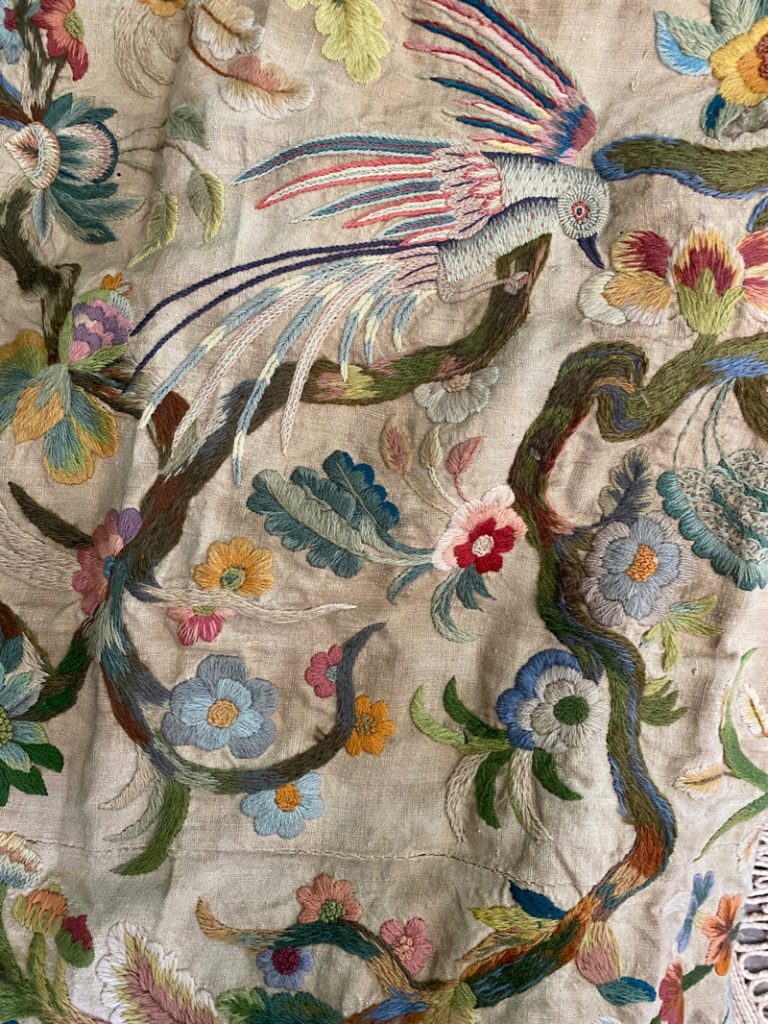
‘After that we went to have lunch.
And he said, Whatever you do, Nigel, you must always think about the client first and do the right thing for them. I don’t mind how much business you bring in. Never be tempted to exaggerate anything. I like to think that in a hundred years time we are dealing with that persons great-great-grandchildren.
My hunting ground was south Hampshire. I was quite interested in furniture. I never made a major mistake, put it that way. I absolutely loved it because I had to look at everything from tribal art to Picasso – well that is tribal art isn’t it?’
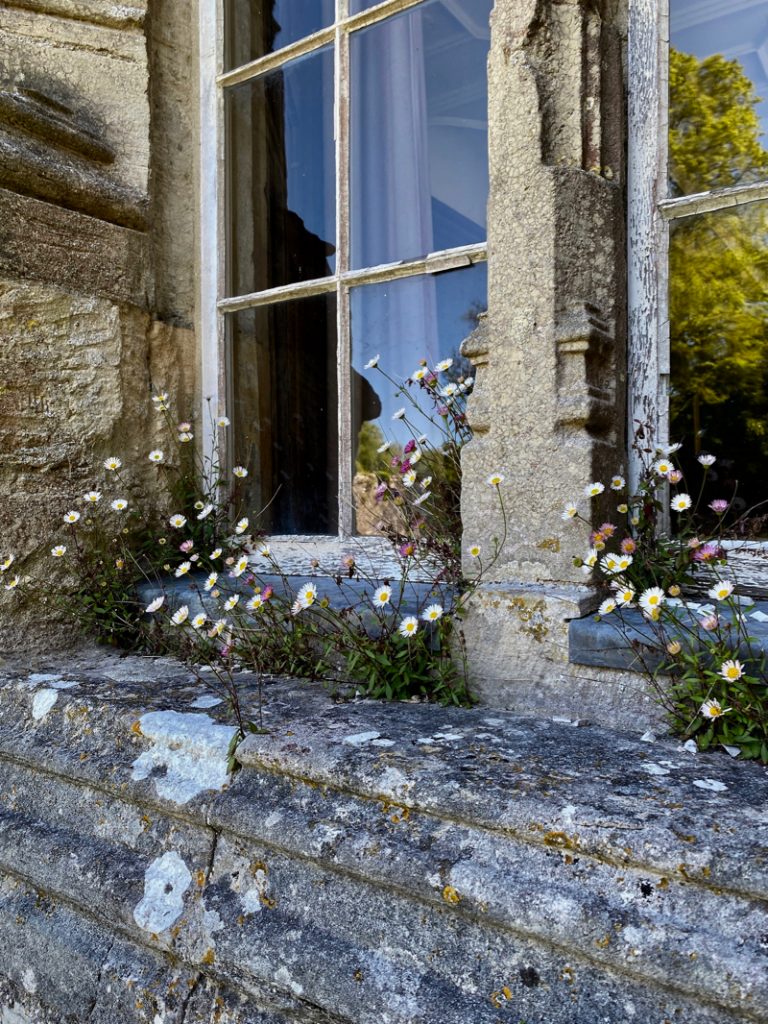
‘When our son Richard was born – that was ‘79 – you’d been without a job for a few years and we’d trudged around looking at antiques and auctions and buying furniture, so you knew what you were looking at. Sometimes he tried to persuade people not to sell things, it was wonderful,’ says Katherine.
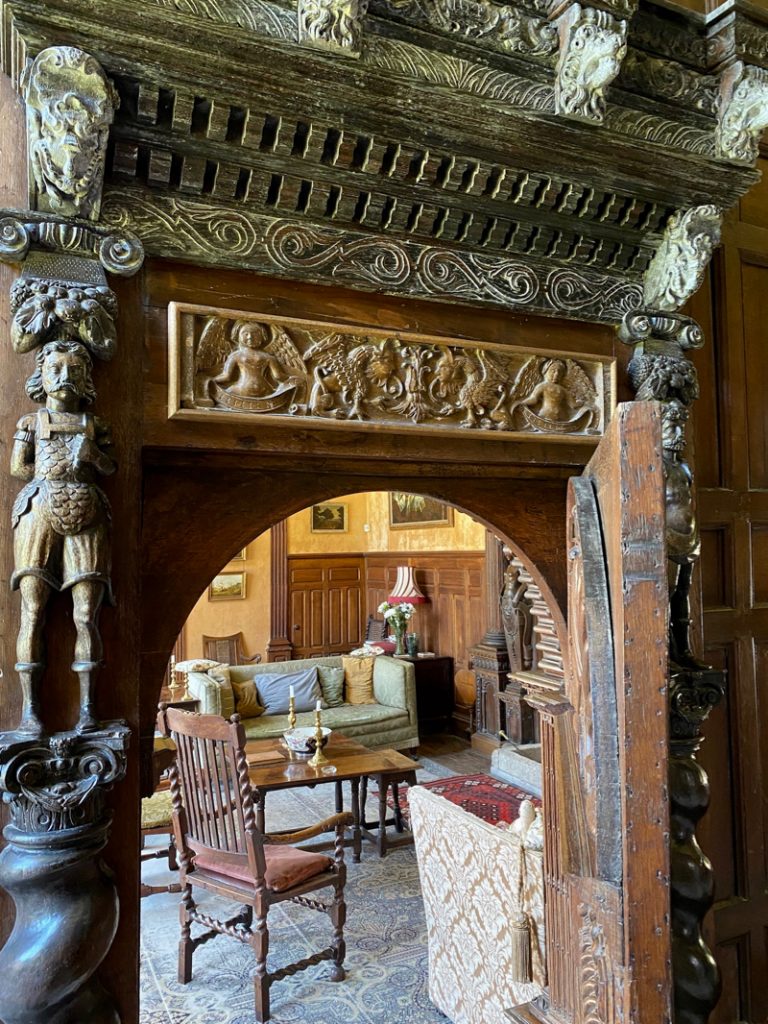
Looking into the Parlour, the carving around the doorway includes a Roman in armour with a hand behind his back
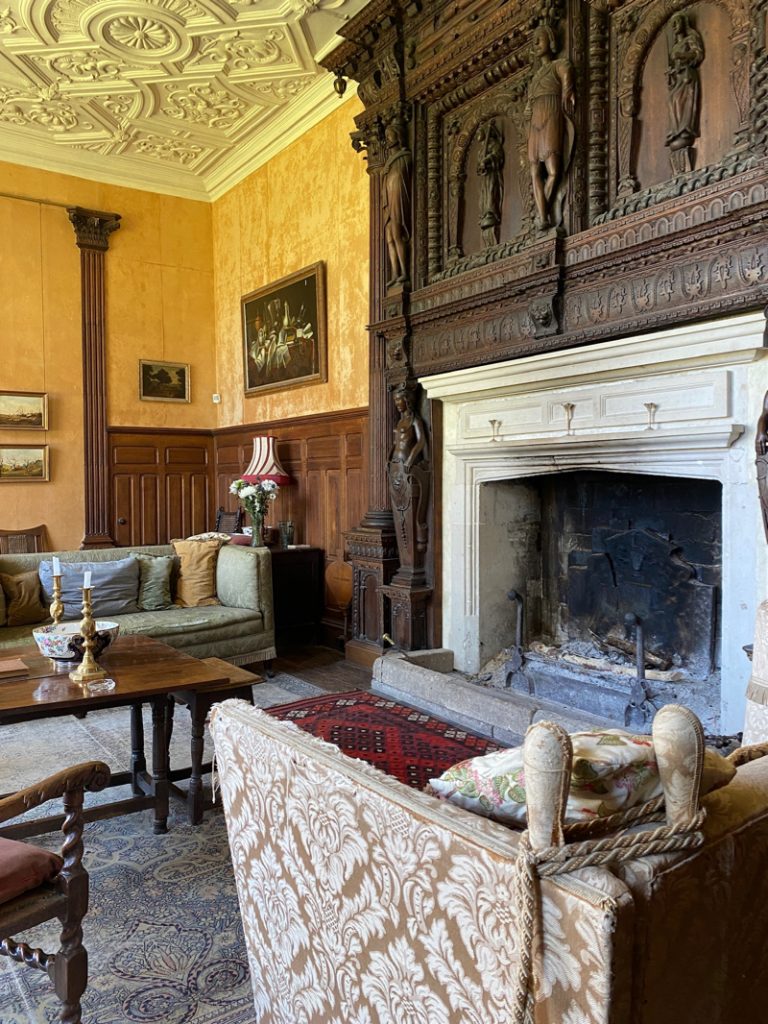
Knole sofa
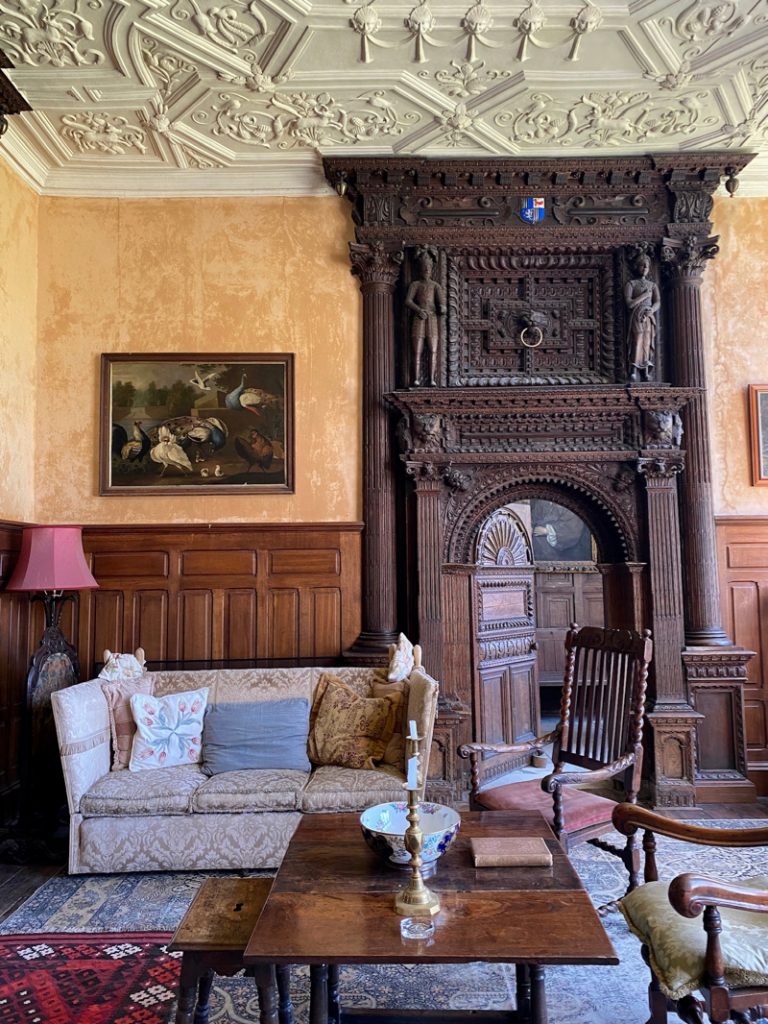
Parlour. Late fifteenth century doorcase carved with a king and queen to commemorate the visit of Philip of Austria and Joanna of Castile in 1506.

‘Priscilla Zamoiska [their predecessor at Wolveton] divided all he house up – her son, Sigismund Zamoiski was an extraordinary, delightful chap. He was about to take all the door handles off and sell them in Dorchester, Pricilla was a battle axe you didn’t argue with her, she stopped him.
Sig’s first job after leaving school was as a warder in Dorchester prison, then he disappeared off the map. I met a chap who been in the far east, in the jungle or something, he met Sig teaching all the little children there – he said he was splendid. Years later somebody met him in America, married to the richest woman in the United States, hob-nobbing with the Kennedys!

The Parlour ceiling is decorated with figures of sheep, horses, oxen, stags and unicorns.
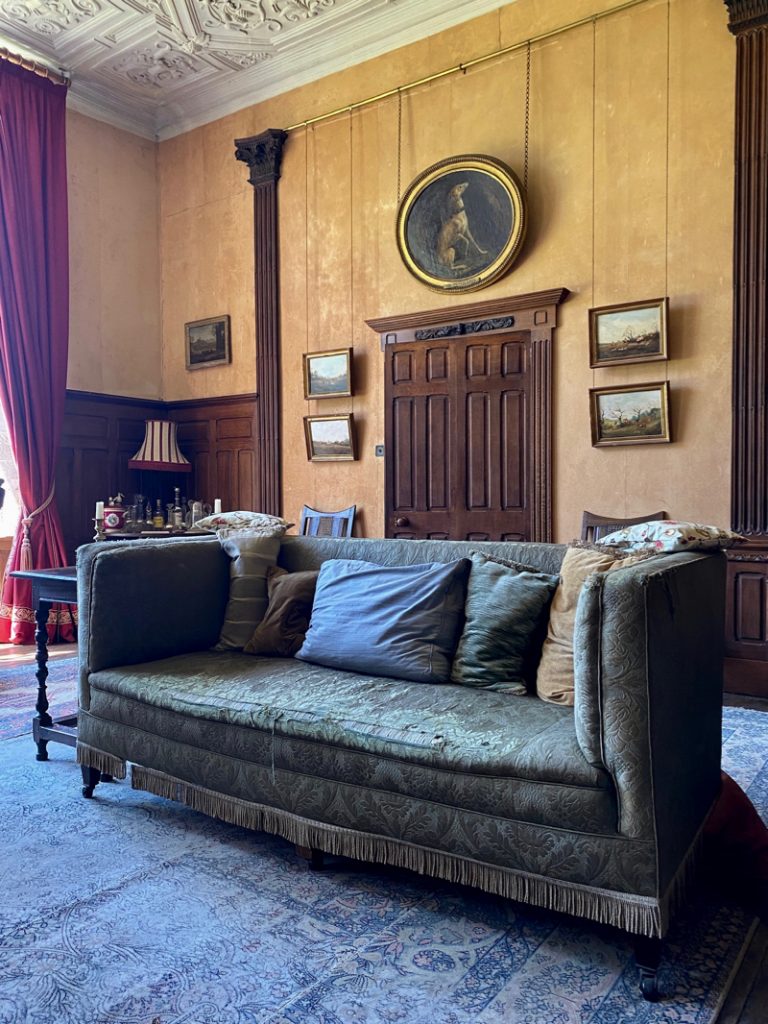
Above the door is Sir Peter Lely’s portrait of a favourite whippet

The dining room, refurbished c.1570
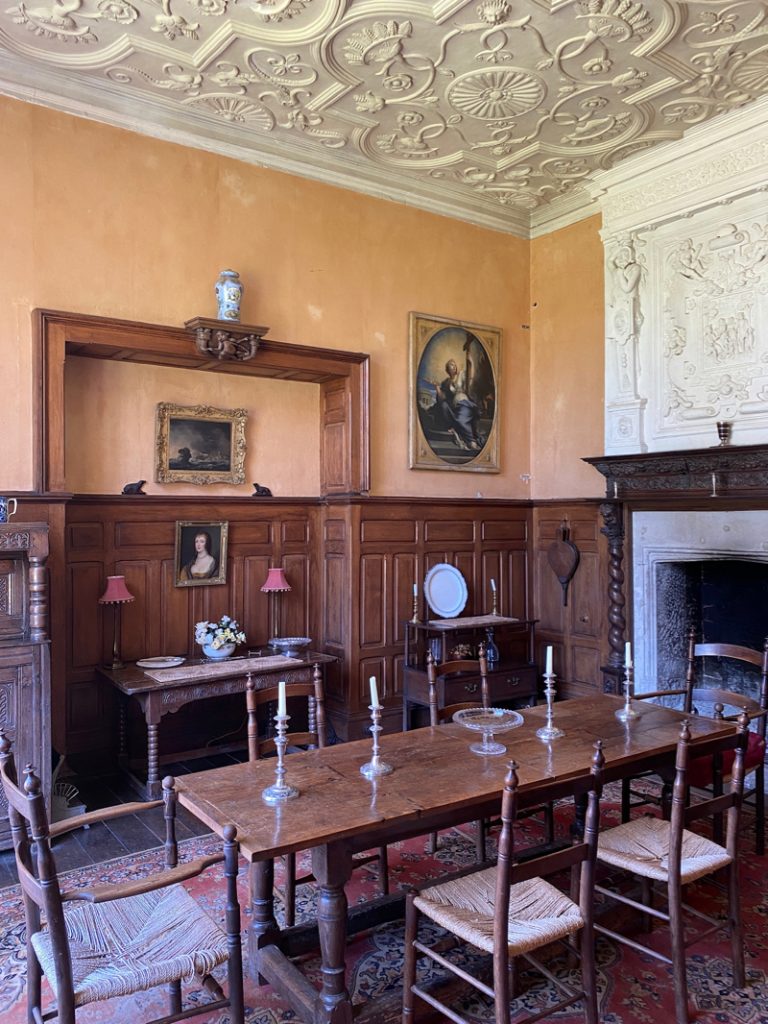
The dining room fireplace has a plaster scene of the Judgment of Paris, the silver-mounted wooden cup over the fireplace is carved from a Mulberry tree reputedly plated by William Shakespeare which fell in the late eighteenth century.
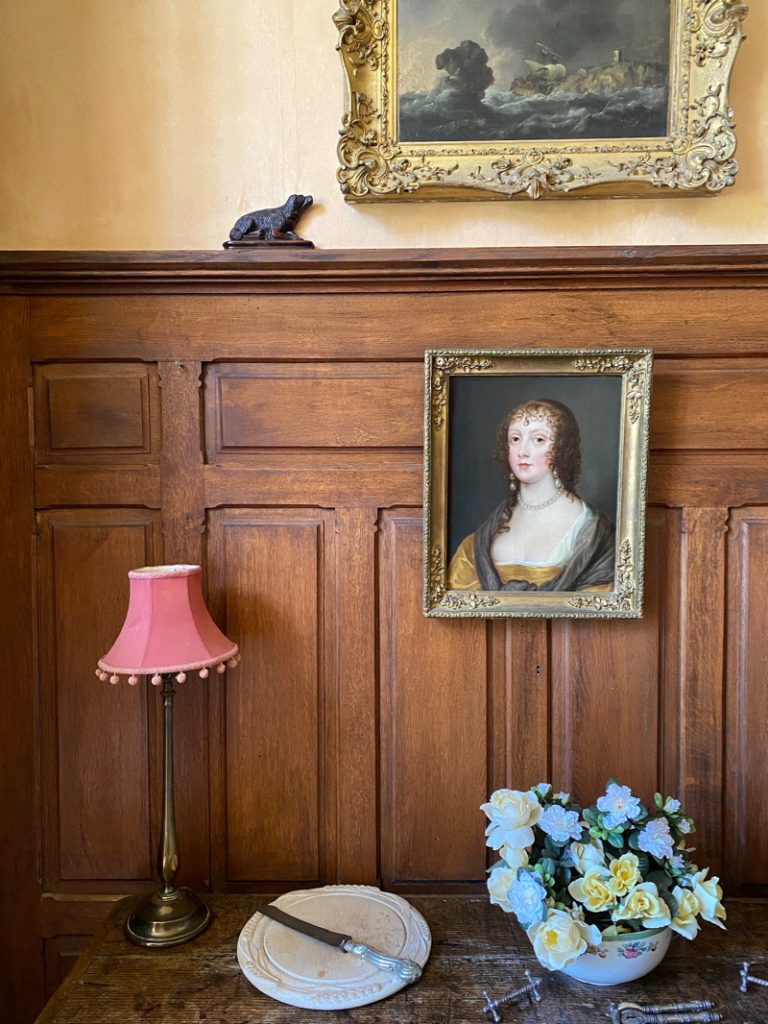
the Countess of Suffolk (sister of Lady Elizabeth Thimbleby) by Van Dyck.
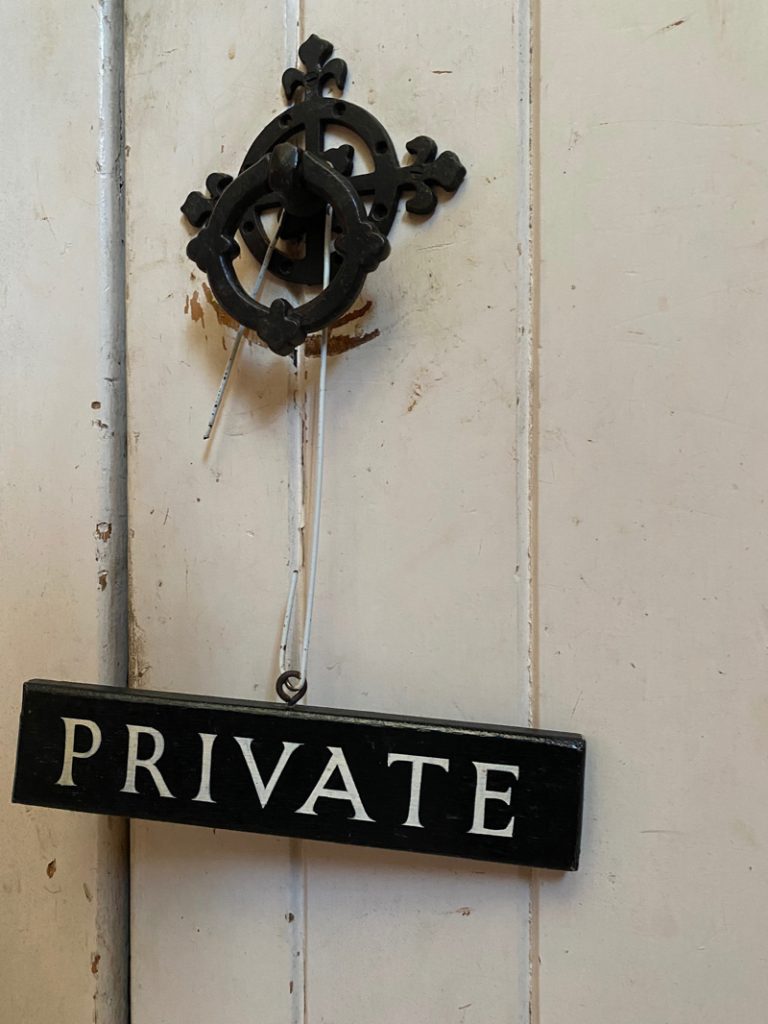
on the Great Staircase…
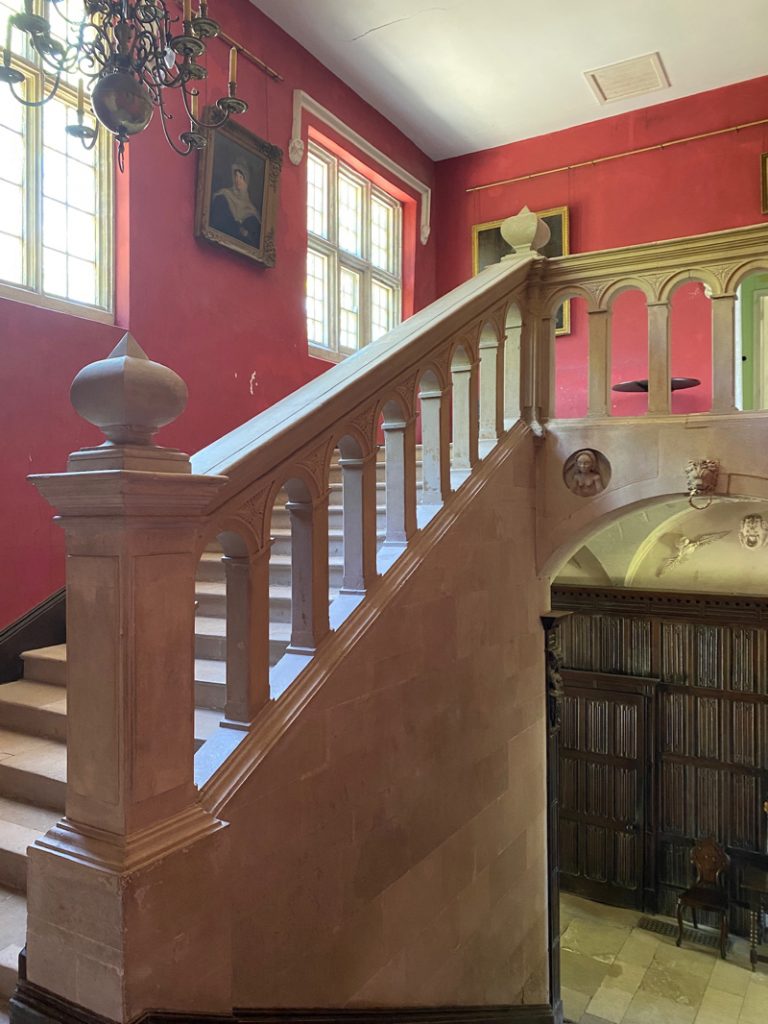
the Great Staircase, built c.1570 by Allen Maynard

the Great Chamber – divided into 5 smaller room c.1820 – which was probably when it lost its barrel-vaulted ceiling; these partitions were removed in 1973.
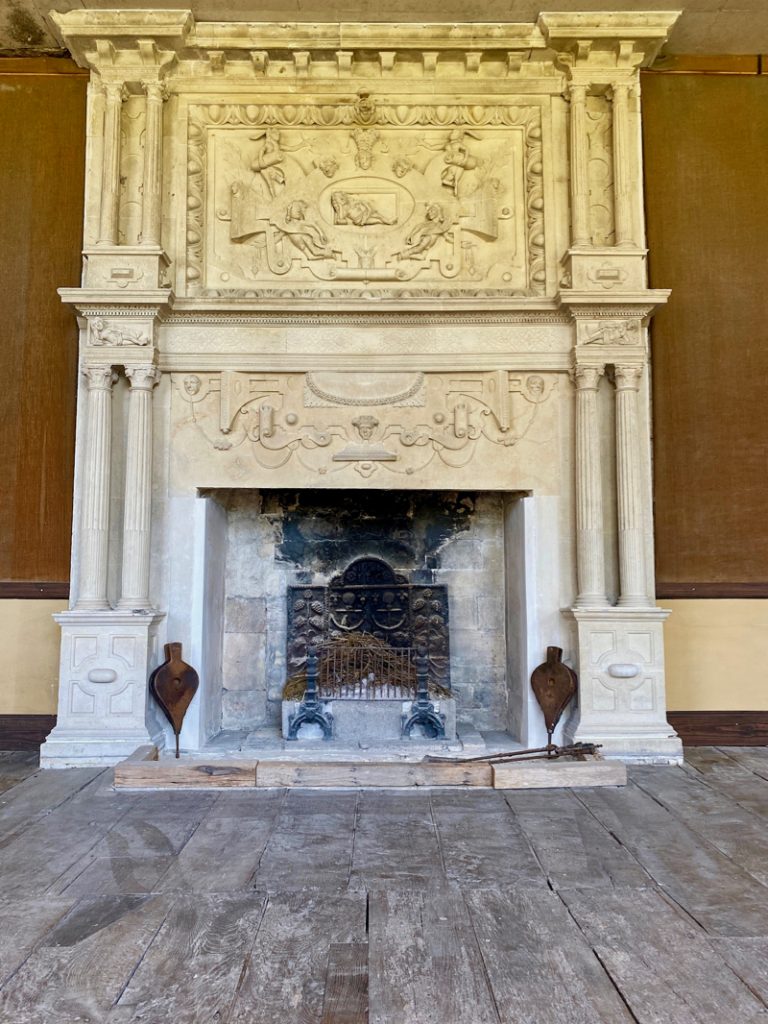
the monumental fireplace is by Allen Maynard, decorated with the figure of native American Indians – Sir Walter Raleigh was a country neighbour who visited Wolfeton and may have suggested this conceit.

‘I’m delighted by this painting in the great chamber of two sisters, one of whom is Lady Elizabeth Thimbleby. With a name like Thimbleby we come from Lincolnshire, but what put me off was the weather and I don’t like the north sea.
There’s another version in the National Gallery, it’s the only picture that Van Dyck painted of two women.’
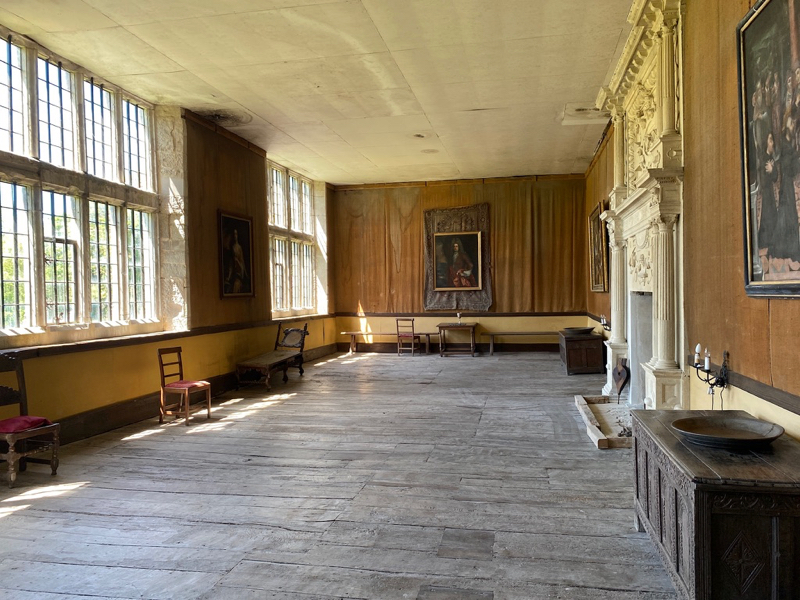
‘I sit up there in that corner to look at this picture, or I go up there to write a letter. But of course, I look at the picture and out of the window and don’t write a letter.
It’s an agreeable house to live in.’
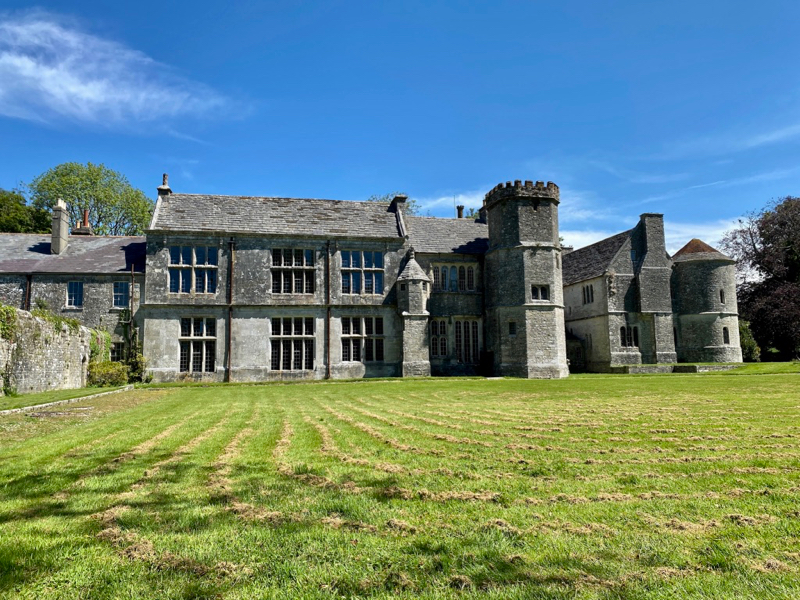
Wolfeton’s south front: looking back at the top floor Great Chamber.
‘When the local council accepted the new development at Poundbury they said it would protect the site – it hasn’t of course. You can see just the tops of the high buildings at Poundbury from the estate. But it has opened people’s eyes architecturally, I think there’s a lot of good in Poundbury.
Architecturally Poundbury has helped.’

Tanks on the Lawn – the proposed new housing development:
Grade I Wolveton House is the diminutive grey building shaped like a backwards ‘L’ to the left of the purple demarcation line
‘But now the developers – Land Value Alliances and the Pegasus Group – have applied for outline planning permission to build 120 houses on a field between us and Charminster. That was turned down; the latest is that it’s now down to 80 houses and it’s going back to the council. The village calls that field Westleaz, the Strawberry Field, because there used to be a pick-your-own there. Years ago, Nigel tried to buy that field from the local farmer but it was withdrawn before the sale. But there isn’t the infrastructure for this – the places in the village school, the roads are narrow… ‘
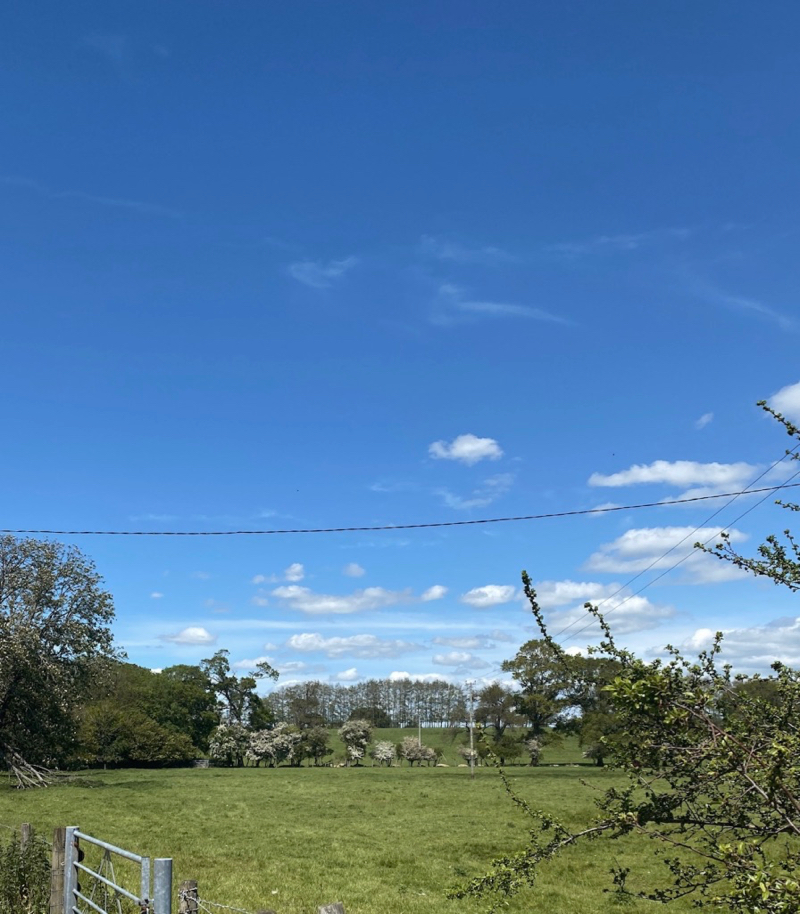
These new houses will mass behind the thin treeline on the edge of these fields bordering Wolveton’s ancient drive. ‘The developer’s statement describes this as ‘ co-visibility between the asset and the development, principally from the driveway to the south,’ and claim that the scheme would bring economic benefits – more than a third of the homes are classed as ‘affordable,’ (which is defined as mortgaged at 20 percent below the market rate).
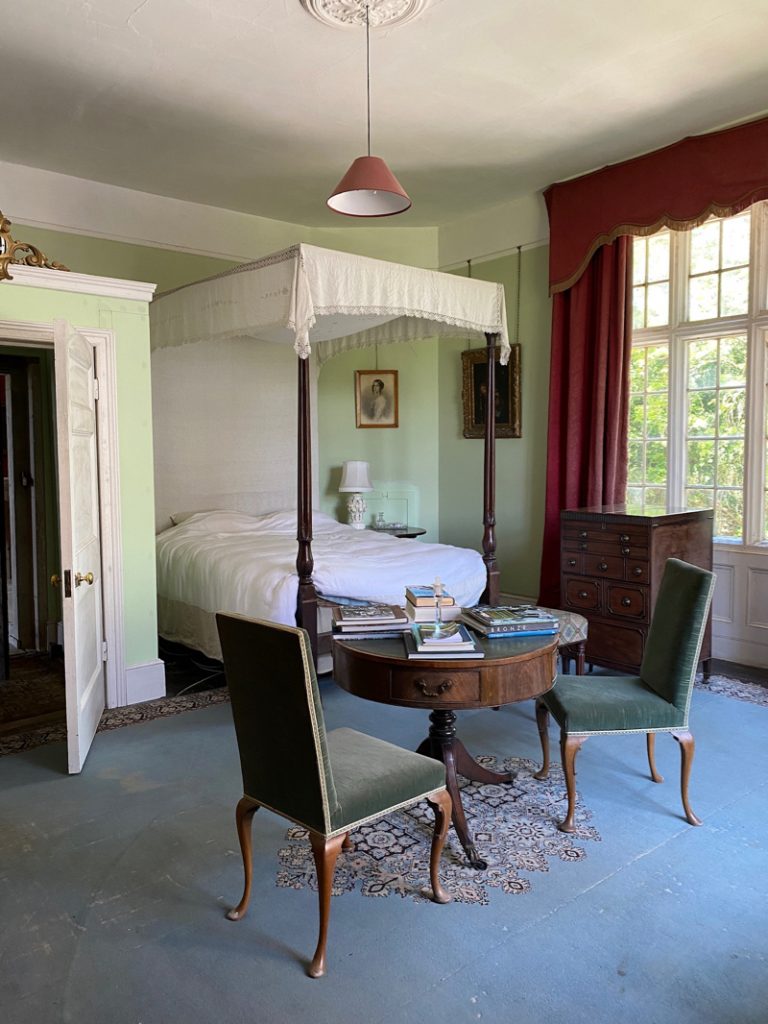
Green bedroom , formerly part of the Long Gallery
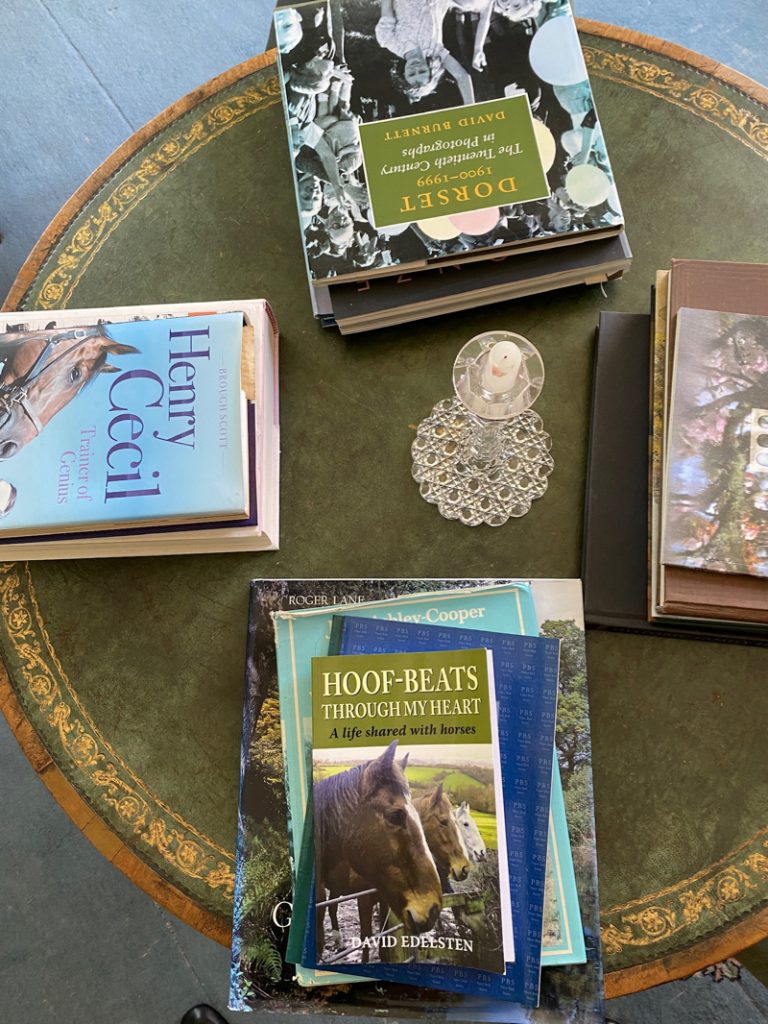
bedtime reading
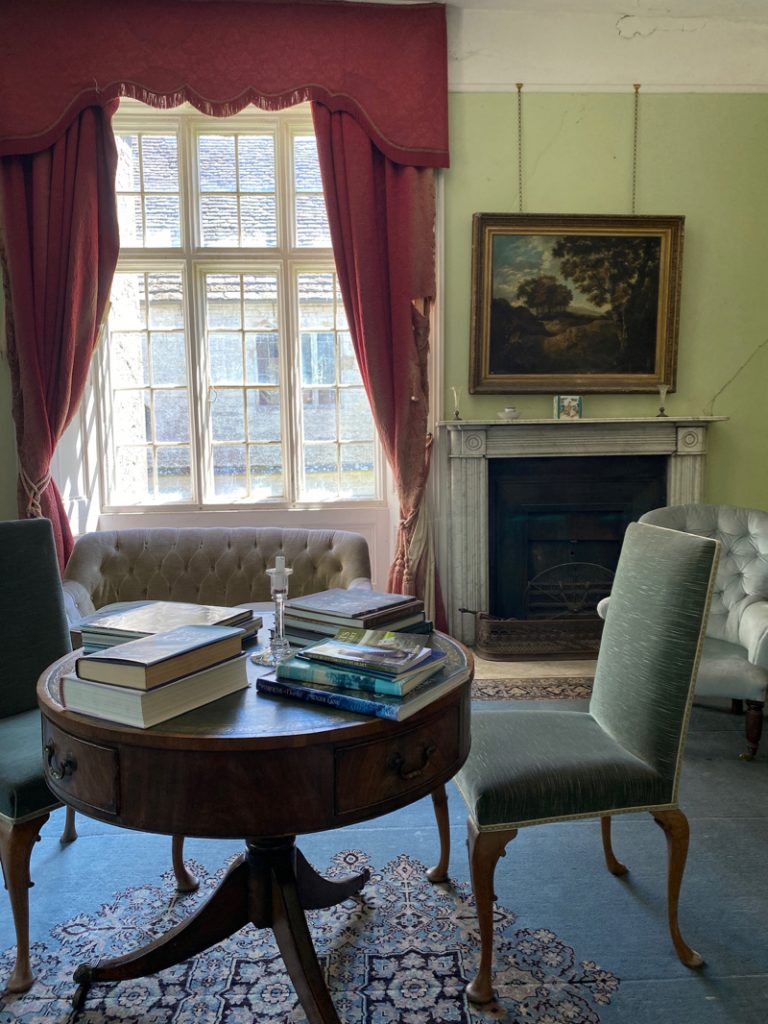
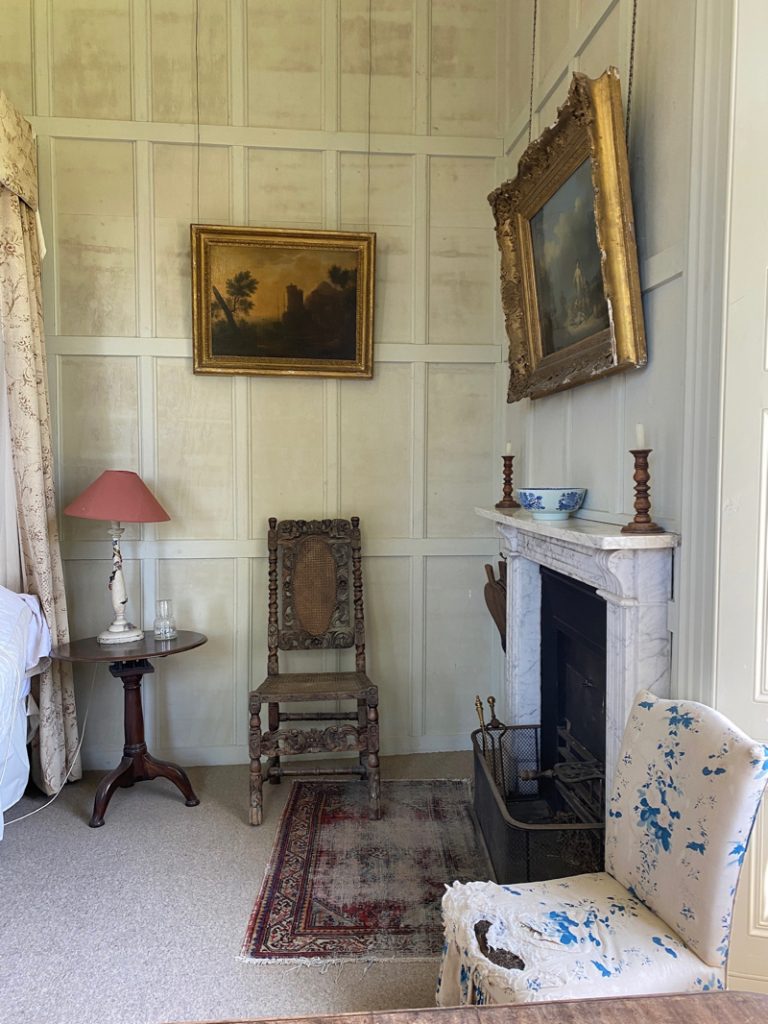
The Long Gallery bedroom

‘Some friends of ours had a big party because they were leaving Dorset, and said – Would you have a couple to stay? It was Victoria Mather who did those cartoons in The Telegraph colour supplement, she arrived with her husband in the most wonderful Mercedes two-seater.
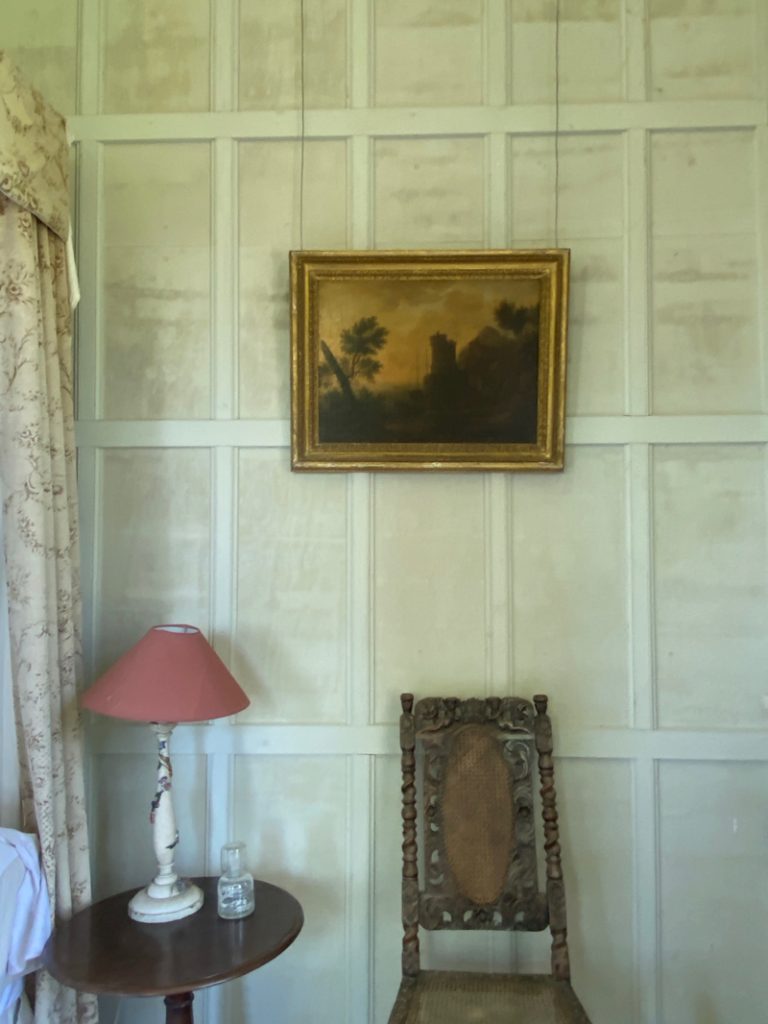
She had Pekineses. I was very, very firm, because the dogs would piddle on these stone floors, having been piddled on for 500 years. But she wouldn’t even put them down in the yard or let them walk with their poor little feet – and all this sort of business;
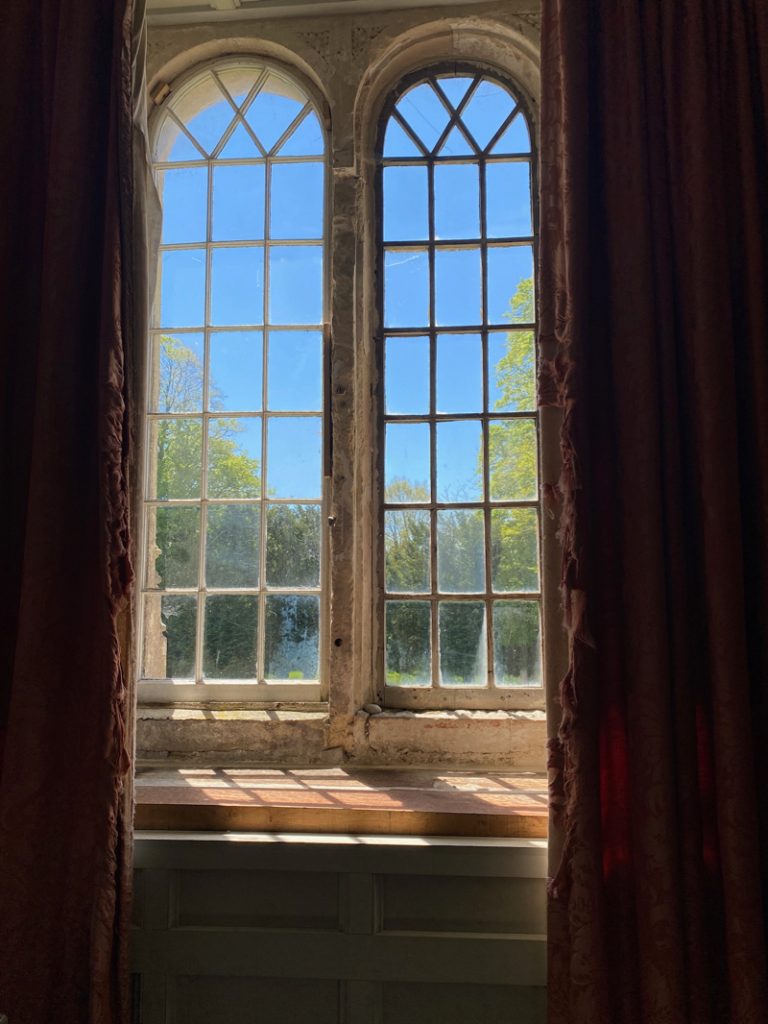
We drove in convoy, and after we got there, she said she wanted to go home – You must come, because we have to follow you. So we went to a wonderful party, came back, and I said to myself, I don’t trust her. So I sat at the bottom of the stairs and she realised she wasn’t going to be able to bring her dogs upstairs. She put the dogs in the car.

What was funny was, the next day I got up and went out to see if they were there. Sitting in the car was her husband with the dogs.
She didn’t like us very much.
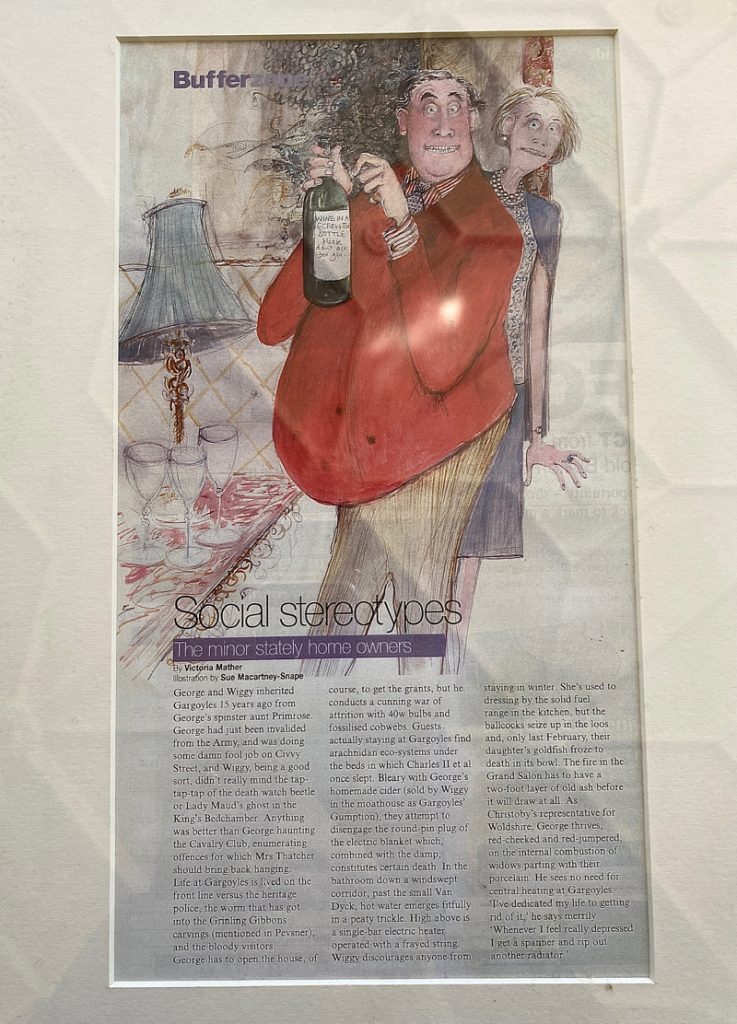
We didn’t get the weekend papers. On Saturday morning three mates of mine rang up and said, This must be you! She hadn’t missed a trick, she’d remembered everything I said.’
‘Sue Macartney Snape did the drawings. I was very cross that she drew screw-top bottles of wine – nowadays we quite often drink screw-top wine, but I those days it was an insult. And Nigel was quite skinny in those days – and putting me in pearls!
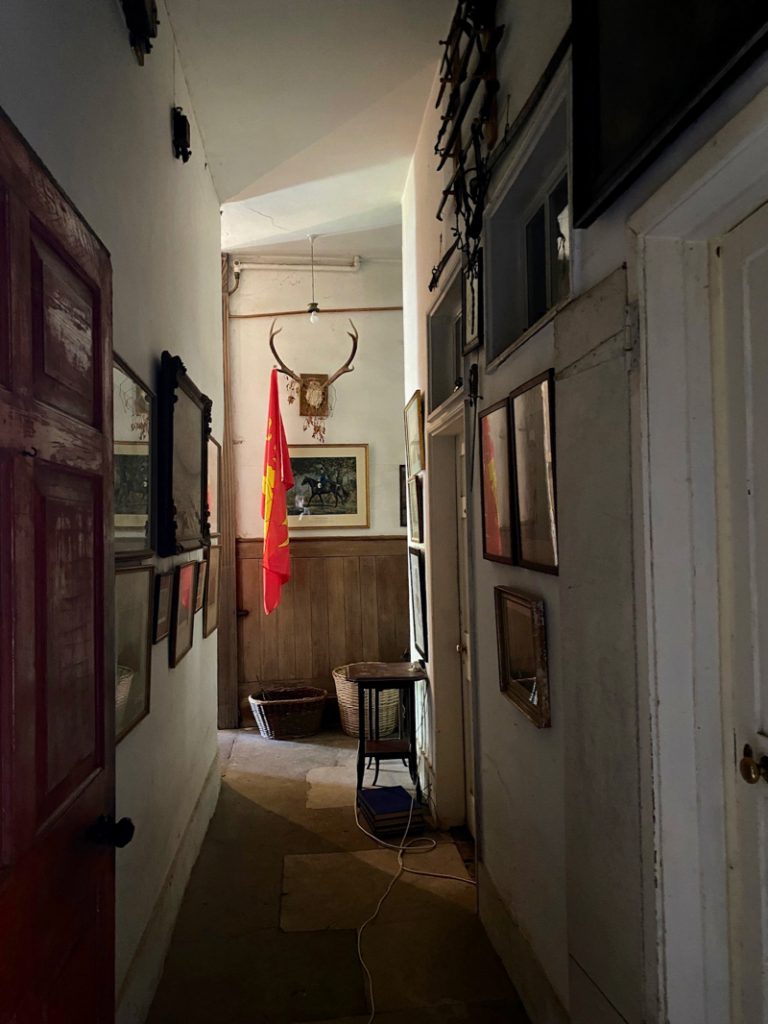
corridor
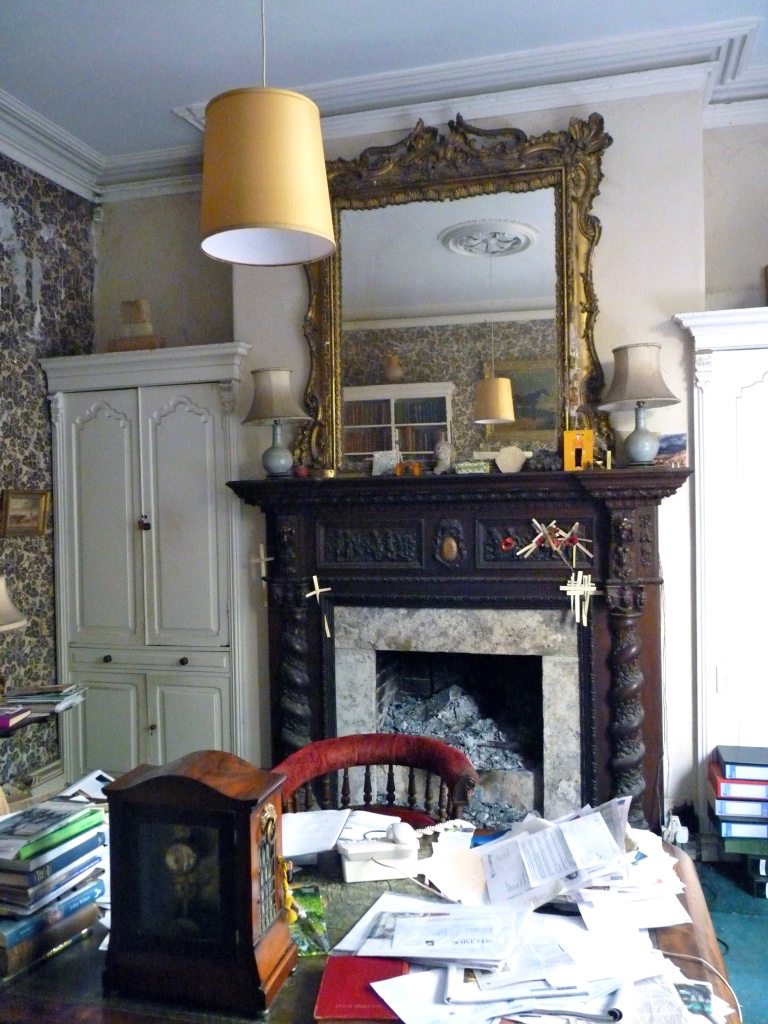
Captain Thimbleby’s study, photographed c.2010 with kind permission, for the bibleofbritishtaste.com
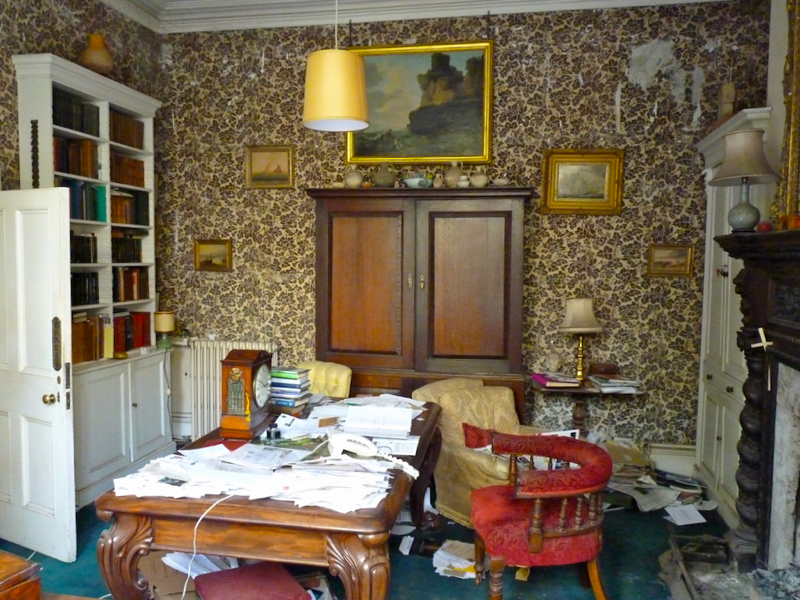
This desk belonged to Admiral Hardy, it was the first thing we bought together in the 60s, at a sale, and it cost £200. Which was quite a lot of money then, and Nigel said, I don’t think I can afford it. (Vice- Admiral Hardy served with Nelson at Trafalgar: Nelson’s famous remark of “Kiss me, Hardy” was directed at him.)
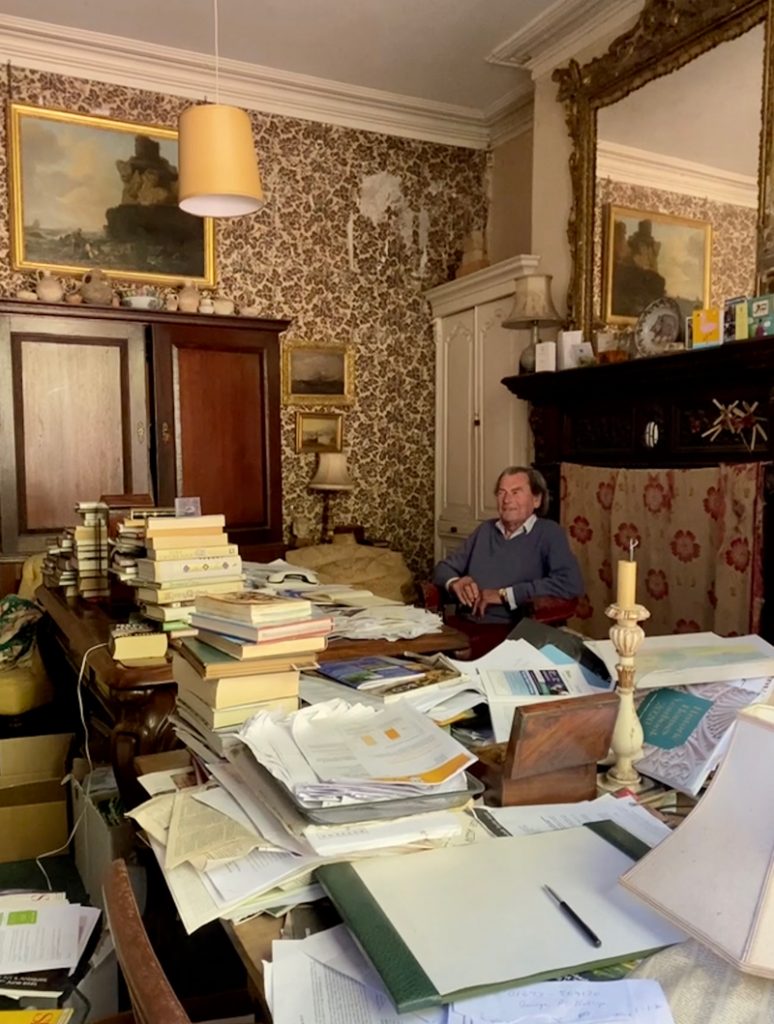
and again in 2021… ‘It’s going to be a horrid photograph, if I’d known I would have tidied up. Now would you like to sit in this chair and I’ll take a photograph of you’
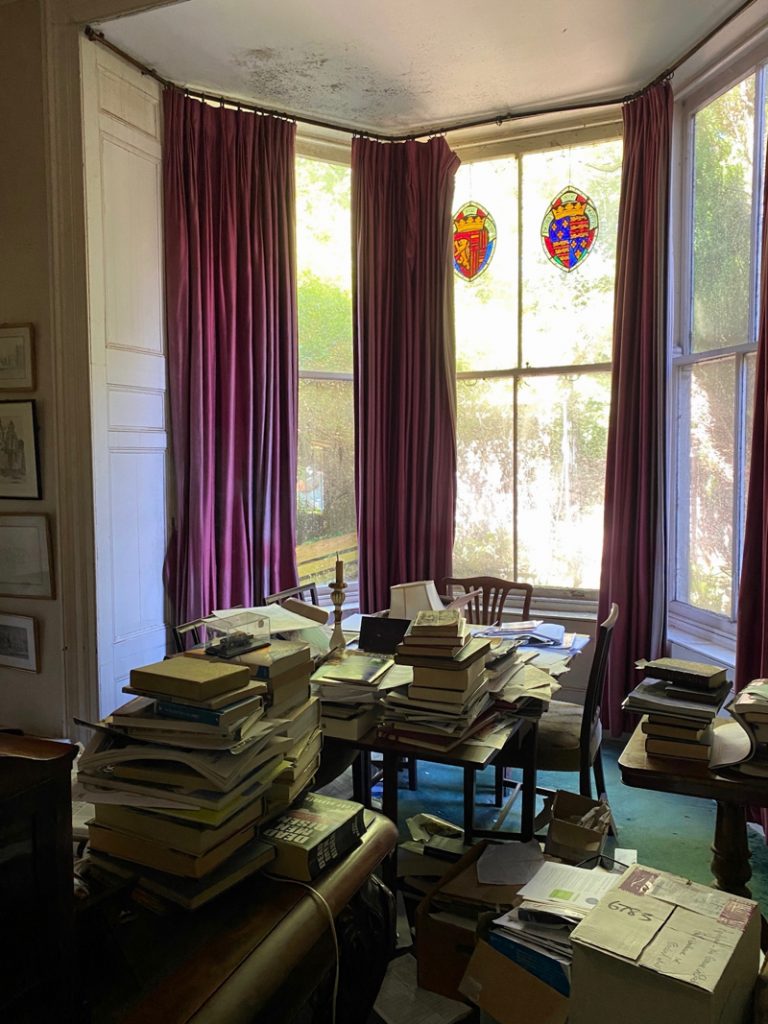
armorial glass

‘The curtains? I was throwing them out – Nigel saved them. The wallpaper predates them, this was my kitchen when we were first married. Priscilla Zamoiska had covered the walls with asbestos, I took it down and found this rather nice wallpaper.’
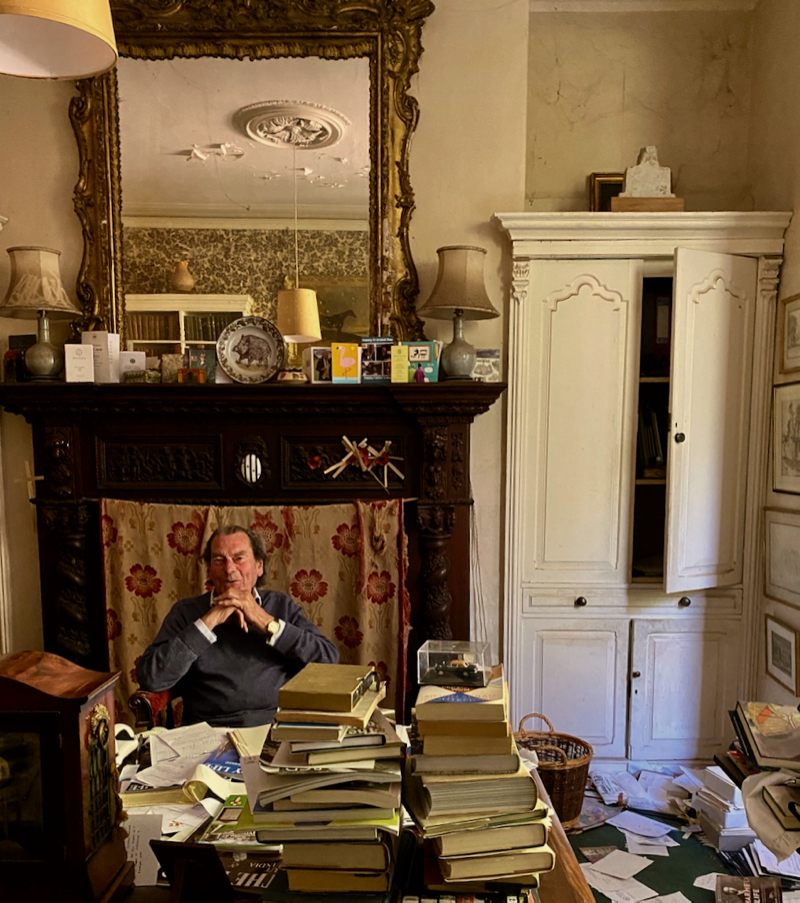
‘I like having the sheep here but they’re not mine. Like everything else, farming is ghastly now, it’s not being out in the field, its being in an office.’

‘Will you put on your blog we’re open to the public?
For tours of the house. Katherine is the tour guide – my wife does it.’
Mondays, Wednesdays, Thursdays, 2-5. no pre-booking required.
www.historichouses.org/wolfetonhouse
Goodbye.
Tally Ho!
To rent Wolfeton’s ancient gatehouse : go to the Landmark Trust
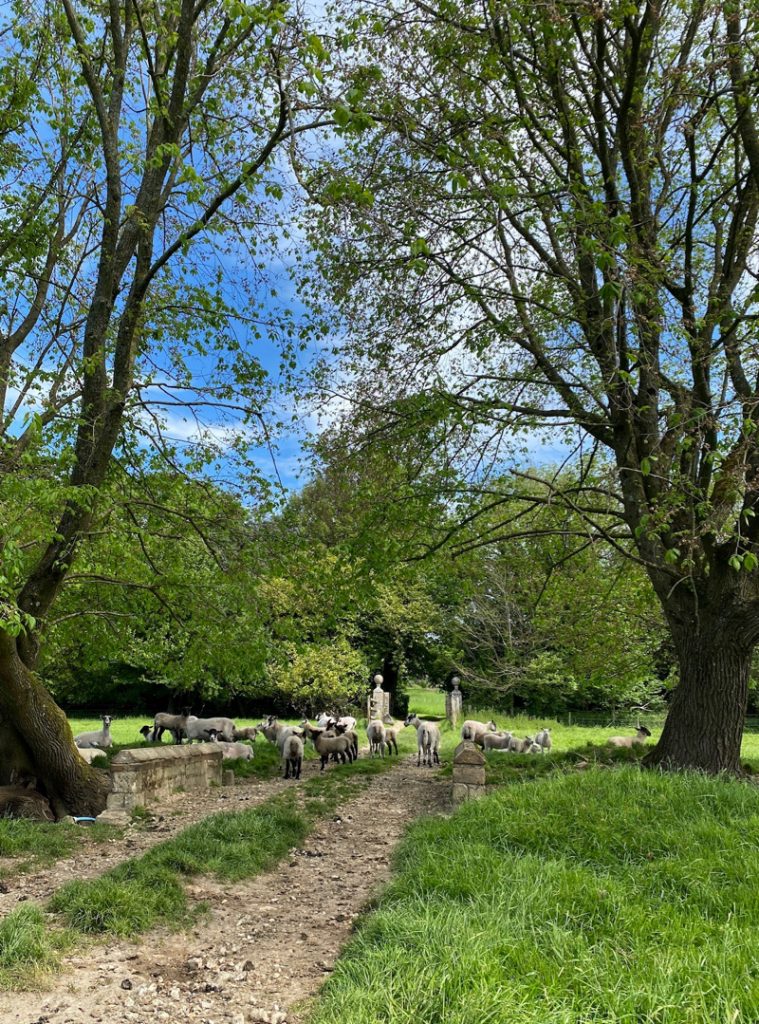
‘Once our countryside is gone, it’s gone and no amount of money can bring it back. What will we have of beauty then to inspire us and feed our souls?’
Very grateful thanks to Captain and Mrs Nigel Thimbleby
All photographs copyright bibleofbritishtaste. Excerpts may be used as long as clear links are supplied back to the original authors and content.

Thank you, Captain and Mrs. Thimbleby, for such an interesting story, and for sharing the photos of your lovely home. Best wishes.
Don’t give up! Thank you for the lovely photos and keeping all the tattered beautiful curtains and wallpapers.
What a wonderful house and what a charming guide. How could Victoria Mather be so ungrateful? (That was some top-shelf snark, however. Kudos for framing it.)
Its a truly wonderful house and he’s a wonderful man. He and house tidier but otherwise little change for more than 30 years.
Absolutely loved this! I have posted a link in our FaceBook Group ‘Stablecourtyards and Riding Halls’ Wolfeton isof great interest to us as it is home to the oldest riding hall in the country.
Totally breaks my heart, this proposed housing development. Ruination of our countryside. Where we live, there is a slow but sure encroachment on our green spaces – they put a crematorium in the once beautiful field in East Renfewshire, not far from Hurlet House. The Hurlet House is now a mosque. Utterly sad. Thank you for the beautiful pictures and the atmosphere.
Just revising the Hengrave Old Girls list, I looked you up. Interesting article & lovely place to live. Sr. Clare Veronica.
I am thrilled to find this article as I have Thimblebys as my ancestors. I live in New Zealand and would love to fill in some gaps in my family tree. I feel sure Captain Nigel Thimbleby or his wife Katherine would have a much more completed family tree than I have managed despite my researching for many years. I was amazed to see the paintings of Lady Elizabeth Thimbleby ( and her sister) as I have printed those myself but not sure where the ladys fit in my family tree. I would dearly like to make contact with Captain Nigel Thimbleby or his wife but not sure how to go about it. Is there any one that can help or advise me please?
Hi Lynne, My grandfather was Adjuvant Tyrwhitt Lumley Lutteral Thimbleby who died in 1959. His father I think was an insurance agent and founder of Thimbleby and Shortland aucioneers and estate agents which still exists in Reading. My mother Margaret Susan Chapman, nee Thimbleby was Lumleys first child and Nigel was mums brother. Nigel sadly recently died, which is actually how i found your post. My mother is in a care home and was talking about Nigel and her younger brother Miles who died some years ago. I have not done much research so i cannot really help you much, but it is one of those things I have been meaning to do! My cousin Anthony lives in NZ so you do have a potential relative there in Auckland. Anthonys mother is Julie, my mother, Nigel and Miles sister. I’ll see if I can find that various bits of research I did a few years ago and let you know. Have you registered at AncestryDNA? I have so we could at least maybe calculate how close we are, there are not too many Thimblebys about, Carey Chapman
I just found this wonderful set of photographs. Researching my family tree, I discovered a direct ancestor in Sir Thomas Trenchard, who lived at Wolfeton in the seventeenth century. It was he who entertained the storm blown Austrian Archduke. Seeing that the house is open for tours, I now hope to visit over the summer. Many thanks for such a detailed look into this wonderful house.
I am also trying to trace the Trenchard family as the maiden name of my wife was Trenchard Smith. she is a descendant or Elizabeth Mary Trenchard (1776-1860) who married Robert Smith (1778-1863) in Crewkerne on 4th October 1800. To date I have managed to trace back through her father John to George and Oliver (1662-1745) who married Mary Hoopper (1662-1694) in Thorncombe 10 October 1682. I’m having some difficulty tracing beyond Oliver but believe his father was John.
It was interesting to see your comments when reading of the Trenchards and Wolferton. Unfortunately living in Melbourne Australia we are unable visit what a wonderful house it must be.
Very sadly Captain Nigel Thimbleby died on Saturday 12th August 2023 aged 87 years and the funeral will take place at Charminster on Friday 1st September.
I can provide you with contact details Email / Telephone etc when required at a later date.
Kind regards
Freddie Wills